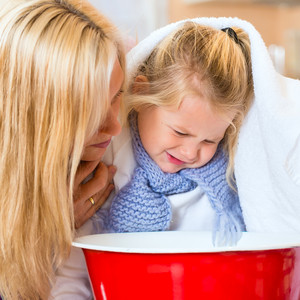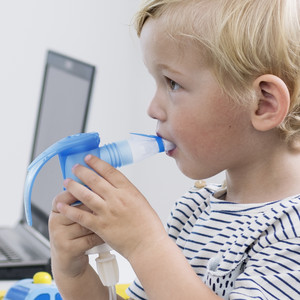When babies and young children have coughs, their parents often have their youngsters inhale hot steam because they assume inhaling steam will relieve their symptoms. This is a misguided belief. This method can even pose serious health risks to children. Read why on the PARI blog.
Every autumn like clockwork colds and respiratory tract infections spread routinely through crèches, nurseries and play schools. It feels like the little ones are sniffling and coughing nonstop from October to March. To help their babies and young children, parents will still take a pan, hot water and a pinch of salt and have their children inhale the hot water vapour tented under a towel. This method hangs on tenaciously despite the fact that inhaling hot water vapour does not have the desired effect and there are risks involved.
Studies show that babies and young children who inhale hot steam can get bad scalds and burns. For example, in a retrospective study the authors Himandi et al. observed patients who were treated at a Welsh burn centre after they were scalded while using steam inhalation. Between the years 2010 and 2015, 16 children aged 1 year to 15 years were treated at the centre. They had burns involving up to 17 per cent of the total body surface area. One child had to be treated surgically and all of the others were given dressings.1
The authors Lonie, Baker and Teixeira retrospectively analysed the medical records of children who visited the accident and emergency department for scalds and burns from steam inhalation over a period of 10 months (November 2014 to August 2015). During this period, 10 children were treated for burns. The average age was between 1.6 and 8 years. In 80 per cent of the cases the burns were on their hands. In five (50%) cases, surgery was necessary, and of these, four were acute and one needed a reconstructive procedure later on. The authors conclude from their study that steam inhalation can result in substantial burns in children. Toddlers are at the highest risk; they frequently had burns on their hands, for which skin grafting had to be performed. The public must therefore be made more aware of the risks of inhaling steam.2
Most accidents happen because the child is curious or their fine motor skills are not well enough developed. The little ones grab at the hot water out of curiosity or slip when holding the bowl. When that happens the hot water can splash on their hands, abdomens and thighs.

Dr Wolfram Rohland is also familiar with the risks of inhaling hot steam. He is a paediatrician who has been in private practice for more than 30 years: “I have had several cases at my surgery where parents had to bring their children in for scalds they got while inhaling steam. And on top of that, inhaling hot steam is generally quite stressful for children. To have to sit bent over a bowl with hot water with a towel on one’s head can be harrowing for children. Using an inhalation device for inhalation is not only more effective, it is also more pleasant for the children. There are well-fitting, child-friendly masks which are simple to use for inhalation.”
Contrary to generally accepted knowledge, inhaling hot steam is not effective. Because during evaporation the substances dissolved in the water (e.g. salt) do not vaporise and instead they stay in the pan. Evaporation results only in the distillate providing moisture. The moisture only reaches the upper airways, like the nose and throat, but not the bronchi and lungs. But the mucus that triggers coughing and needs to be dislodged through inhalation is found in the bronchi and lungs.
As Dr Rohland the paediatrician also repeatedly explains to parents and his patients: “Inhaling steam is considered a home remedy for colds and coughs. But I recommend using a nebuliser for inhalation because this is the only effective method of inhalation. Using an inhalation device with a jet or membrane nebuliser is the only way to ensure that the fluid being inhaled is vaporised into tiny particles. Only very fine nebulised particles can get into the bronchi and bronchioles and have an effect. This is not a given when inhaling hot water vapour.”
It is not unusual for children in the first three years of life to experience so-called obstructive bronchitis caused by viruses. This is accompanied by respiratory distress which can also range from very severe to life-threatening. During exhalation there is a typical wheezing sound, also called rhoncus. The children have difficulty exhaling as a result of the inflammatory mucus build-up in the bronchial tubes, similar to asthma patients.
“It is precisely when children who have respiratory infections become obstructive, which means the airways constrict, that inhalation using an inhalation device and a nebuliser is appropriate and effective. The devices ensure that the medications can be administered straight to the bronchi,” explains the paediatrician. In this case, inhaling a hypertonic saline solution, i.e. a saline solution with 3 or 6 per cent salt, not only helps to better dislodge the inflammatory mucus, but also has the effect of reducing swelling in the mucous membranes, in Rohland’s experience.

If children are experiencing obstruction and respiratory distress they may have to be prescribed medications which dilate the airways. They can be taken in tablet form or be inhaled using a jet nebuliser. For Dr Rohland the paediatrician there are clear advantages to using inhalation over taking tablets orally: “In most cases inhalation of these types of medications is preferable to taking them orally because inhaling medications is gentler on the sick child’s body. If medications are taken orally they get into the bloodstream via the gastrointestinal tract and act systemically, that is in the entire body, not just the lungs. With inhalation the medication goes only into the lungs, in other words exactly where the medication is needed.”
Conclusion: When coughs and lower respiratory tract infections require treatment, steam inhalation is ineffective. Inhaling hot steam is also unpleasant and stressful for children. In addition, it involves serious hazards due to the risk of scalding and burns for babies and children. In contrast, inhalation using a nebuliser is effective, easy to perform and risk-free.
Dr Wolfram Rohland has worked as a paediatrician for more than 30 years. His paediatric medical practice in Erding, Germany, specialises in asthma and allergology, as well as other specialties.
Note: The information in this blog post is not a treatment recommendation. The needs of patients vary greatly from person to person. The treatment approaches presented should be viewed only as examples. PARI recommends that patients always consult with their physician or physiotherapist first.
An article written by the PARI BLOG editorial team.
© 2025 PARI GmbH Spezialisten für effektive Inhalation